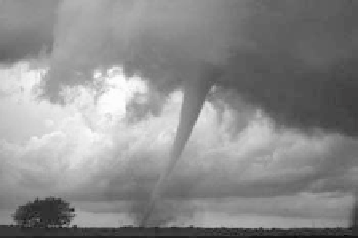Geoscience Reference
In-Depth Information
Figure 5.4 F3 tornado in Oklahoma, May 3, 1999. (National Oceanic and
Atmospheric Administration/National Severe Storms Laboratory.)
nearly an hour and a half along a 38-mile path. The death toll was 46, with 800
injured, and more than 8000 homes destroyed. Property damage was estimated at
nearly $1.5 billion.
11
Consequences of Tornadoes
The damages caused by a tornado are dependent on several factors including the
size of the tornado and the structural integrity of the object being impacted. An
EF-0 tornado can cause damage to mobile homes, carports, and canopies, while
not causing much (if any) to a reinforced brick structure. Also, it must be noted that
tornadoes can be preceded by hail, which can cause damage as well. Some of the
secondary effects of tornadoes can include infrastructure damage, mass casualties,
damage or destruction of businesses and residences (leading to economic recovery
and temporary housing needs), and hazardous material incidents.
Preparation and Planning
The Emergency Manager that works in a location prone to tornadoes must know
the different definitions for tornadoes, and their associated watches and warnings.
These will assist in prompting actions needed to protect lives and the public before,
during, and after tornadic event.
Funnel Cloud—This is a sign of a developing tornado, and consists of a vio-
lent rotating column of air that
does not
touch the ground. People commonly
mistakenly call these tornadoes.
Waterspout—There are wo types: (1) Nontornadic, which are not associated
with supercell thunderstorms, are the most common type, and usually rate
no higher than an EF-0 on the Enhance Fujita Scale. (2) Tornadic are torna-
does over water and usually form in connection with severe thunderstorms.

